With scuba diving locations beckoning, this article invites you to dive into the extraordinary realm beneath the waves. From vibrant coral reefs teeming with life to awe-inspiring underwater landscapes, we unveil the secrets of the most captivating scuba diving destinations worldwide.
As you venture into these underwater havens, you’ll encounter an array of marine wonders, explore diverse ecosystems, and create memories that will last a lifetime. Dive into the depths and discover the wonders that await.
Top Scuba Diving Destinations
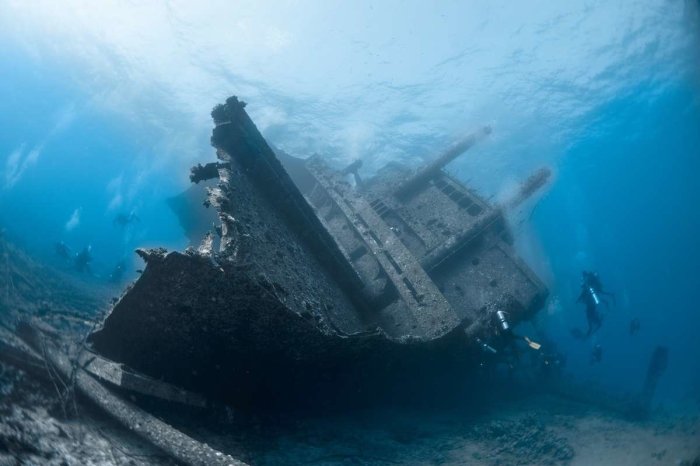
The world’s oceans are home to a vast array of incredible scuba diving destinations, each offering unique experiences for divers of all levels. From vibrant coral reefs teeming with marine life to awe-inspiring underwater wrecks, there’s something for everyone to discover beneath the waves.
Venturing beneath the ocean’s surface unveils a captivating world of marine wonders. Scuba diving offers a gateway to these underwater realms, where divers encounter vibrant coral reefs teeming with life, explore mysterious shipwrecks, and witness awe-inspiring marine creatures. Whether seeking adventure in the azure waters of the Caribbean or discovering hidden gems in the depths of the Pacific, there’s a scuba diving location to suit every diver’s dreams.
To help you plan your next scuba diving adventure, here’s a list of some of the most popular destinations worldwide, along with specific dive sites and their unique features:
Asia-Pacific
- Great Barrier Reef, Australia: The largest coral reef system in the world, home to over 1,500 species of fish and 400 species of coral.
- Raja Ampat, Indonesia: A remote archipelago with pristine coral reefs and abundant marine life, including manta rays, sharks, and turtles.
- Komodo National Park, Indonesia: Known for its Komodo dragons, but also offers excellent scuba diving with diverse marine life and strong currents.
Europe, Scuba diving locations
- Maldives: A tropical paradise with crystal-clear waters and over 1,000 coral islands, offering world-class diving experiences.
- Red Sea, Egypt: Home to some of the most famous dive sites in the world, including the SS Thistlegorm wreck and the Blue Hole.
- Canary Islands, Spain: Volcanic islands with clear waters and diverse marine life, including angel sharks and stingrays.
Americas
- Cozumel, Mexico: Known for its pristine coral reefs and abundant marine life, including eagle rays, dolphins, and sea turtles.
- Galapagos Islands, Ecuador: A unique archipelago with diverse marine life, including sea lions, penguins, and hammerhead sharks.
- Grand Cayman, Cayman Islands: Home to Stingray City, where divers can interact with hundreds of stingrays in shallow waters.
Other Regions
- Sipadan Island, Malaysia: A small island with world-class diving, known for its abundant marine life and visibility of up to 100 meters.
- Socorro Islands, Mexico: A remote archipelago in the Pacific Ocean, home to giant manta rays and other pelagic species.
- Palau: A Micronesian archipelago with pristine coral reefs and unique marine life, including jellyfish lakes and dugongs.
| Destination | Dive Site | Marine Life Highlights | Visibility |
|---|---|---|---|
| Great Barrier Reef | Lady Elliot Island | Mantas, sharks, turtles | 20-30 meters |
| Raja Ampat | Misool Island | Whale sharks, manta rays, pygmy seahorses | 15-25 meters |
| Maldives | Maaya Thila | Sharks, rays, tuna | 25-30 meters |
| Red Sea | SS Thistlegorm | Wreck diving, marine life | 15-20 meters |
Scuba Diving Safety Considerations
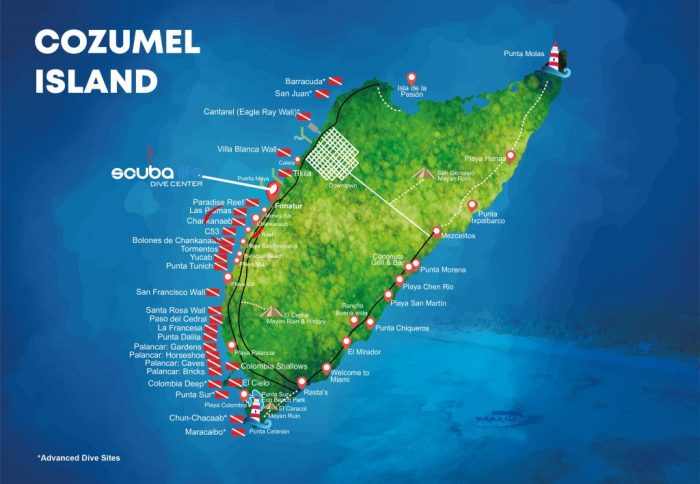
Scuba diving offers thrilling experiences but necessitates adhering to strict safety protocols to ensure an enjoyable and hazard-free adventure. Proper training, certification, and meticulous equipment checks are paramount for a safe dive.
Essential Safety Protocols
A comprehensive safety protocol encompasses:
- Thorough equipment inspection before each dive, including regulators, buoyancy compensators, and dive computers.
- Meticulous dive planning, considering factors such as dive site conditions, depth, and duration.
- Establishing clear emergency procedures, including hand signals, communication methods, and ascent protocols.
Importance of Proper Training and Certification
Formal training and certification are indispensable for safe scuba diving. They provide:
- Comprehensive knowledge of diving techniques, physics, and physiology.
- Practical skills in equipment handling, buoyancy control, and emergency response.
- Recognition and mitigation of potential hazards.
Safety Protocol Importance Example Consequence of Neglect
| Equipment Checks | Ensures reliable and functioning gear. | Diving with faulty equipment increases risk of accidents. |
| Dive Planning | Prevents exceeding limits, minimizes risks. | Unplanned dives can lead to exhaustion, decompression sickness. |
| Emergency Procedures | Facilitates effective response to incidents. | Lack of emergency protocols can result in panic, accidents. |
Adhering to Safety Guidelines
Scuba divers must strictly adhere to established safety guidelines, including:
- Staying within designated dive limits.
- Maintaining neutral buoyancy.
- Ascending slowly to prevent decompression sickness.
- Avoiding alcohol and drugs before or during dives.
By prioritizing safety, scuba divers can minimize risks and maximize the enjoyment of their underwater adventures.
Types of Scuba Diving
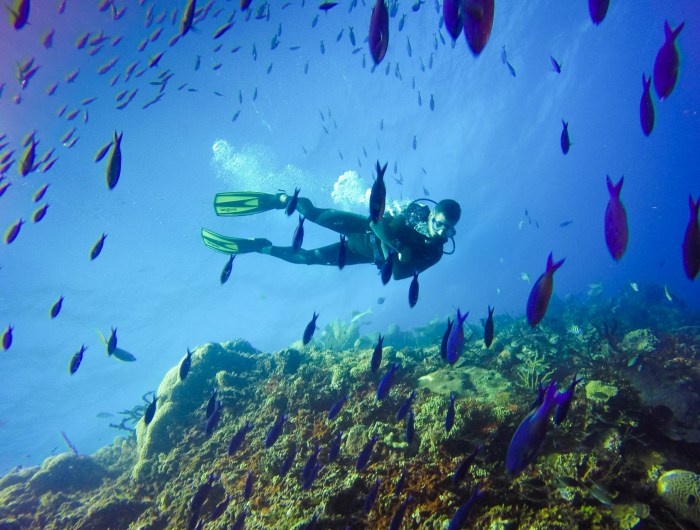
Scuba diving encompasses various types, each with distinct characteristics, requirements, and challenges. Understanding these types is crucial for divers to choose the appropriate dive experiences and ensure their safety.
Recreational Diving
Recreational diving is the most common type, aimed at exploring underwater environments for leisure and enjoyment. It involves diving within recreational limits, typically at depths of less than 100 feet.
Requirements:
- Basic scuba certification (e.g., PADI Open Water Diver)
- Appropriate diving equipment
- Good physical health
Challenges:
- Staying within depth limits
- Managing buoyancy and air consumption
- Dealing with common underwater hazards (e.g., currents, visibility)
Technical Diving
Technical diving involves exploring deeper and more challenging environments, often beyond recreational limits. It requires specialized equipment, advanced training, and a high level of skill.
Requirements:
- Advanced scuba certifications (e.g., PADI Advanced Nitrox Diver, PADI Trimix Diver)
- Specialized diving equipment (e.g., rebreathers, closed-circuit systems)
- Extensive diving experience and training
Challenges:
- Managing decompression sickness risks
- Dealing with deep water environments and potential hazards (e.g., wrecks, caves)
- Using specialized equipment and maintaining situational awareness
Cave Diving
Cave diving involves exploring underwater caves, which presents unique challenges and requires specialized skills. Divers navigate through narrow passages, often with limited visibility and potential for entrapment.
Requirements:
- Advanced cave diving certifications (e.g., PADI Cave Diver)
- Specialized cave diving equipment (e.g., cave line reels, underwater scooters)
- Extensive cave diving experience and training
Challenges:
- Maintaining buoyancy and navigating in confined spaces
- Managing silt and visibility issues
- Dealing with potential hazards (e.g., cave collapses, water flow changes)
Marine Life Encounters
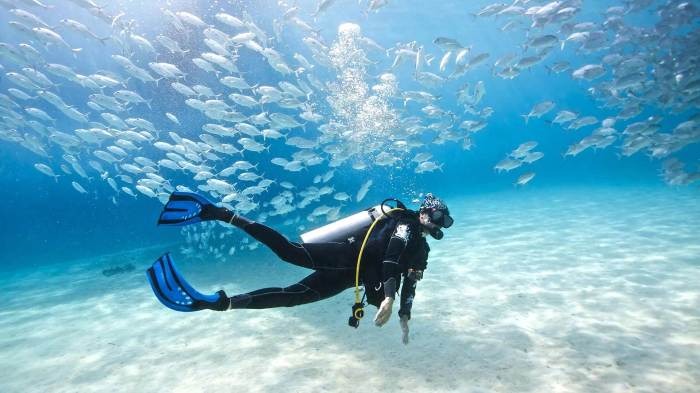
Scuba diving offers an unparalleled opportunity to witness the incredible diversity of marine life up close. From vibrant coral reefs teeming with tropical fish to majestic sharks and gentle sea turtles, the underwater world is a treasure trove of fascinating creatures.
Encounters with marine life can be both awe-inspiring and educational. Divers can learn about the unique behaviors, adaptations, and conservation challenges faced by these species. Understanding the importance of protecting marine ecosystems is crucial for ensuring their survival and the health of our oceans.
Fish
- Examples: Clownfish, angelfish, butterflyfish
- Behaviors: Colorful and diverse, these fish often form symbiotic relationships with other species, such as anemones.
- Conservation Status: Many species are threatened by overfishing and habitat loss.
Sharks
- Examples: Great white sharks, tiger sharks, nurse sharks
- Behaviors: While often feared, sharks are generally not aggressive towards humans. They play a vital role in maintaining ocean ecosystems.
- Conservation Status: Many shark species are threatened by overfishing and habitat degradation.
Mammals
- Examples: Dolphins, whales, seals
- Behaviors: These intelligent and social animals often interact with divers, displaying playful and curious behaviors.
- Conservation Status: Some species, such as the vaquita, are critically endangered due to habitat loss and hunting.
Underwater Photography and Videography: Scuba Diving Locations
Capture the captivating beauty of the underwater world through the lens of a camera. Underwater photography and videography allow you to preserve and share the vibrant colors, diverse marine life, and ethereal landscapes that lie beneath the surface.
To embark on this exciting adventure, it’s essential to understand the techniques and equipment that will elevate your underwater shots. This guide will provide insights into composition, lighting, and post-processing, along with recommendations for the best gear.
When searching for the best scuba diving locations, it’s important to consider factors like visibility, marine life, and accessibility. Scuba diving locations such as the Great Barrier Reef, the Red Sea, and the Galapagos Islands offer unforgettable experiences with diverse underwater ecosystems and thriving marine life.
Researching and selecting the right destination will ensure a memorable and enriching scuba diving adventure.
Photography Techniques
- Use a strobe or video light: Illuminate your subjects and reduce backscatter, enhancing visibility and capturing vibrant colors.
- Shoot in RAW format: Preserve the maximum amount of image data, allowing for greater flexibility in post-processing.
- Control your buoyancy: Maintain neutral buoyancy to avoid disturbing the marine environment and capture steady shots.
- Focus on the eyes: Capture the essence of marine life by focusing on their eyes, which are often the most expressive feature.
- Experiment with angles: Explore different perspectives by shooting from above, below, or at eye level with your subjects.
Equipment Recommendations
- Camera: Consider a dedicated underwater camera or a DSLR with an underwater housing for optimal image quality and control.
- Lens: Choose a wide-angle lens to capture the vastness of underwater scenes or a macro lens for close-up shots of marine life.
- Strobe or video light: Select a powerful strobe or video light to illuminate your subjects and reduce backscatter.
- Buoyancy compensator device (BCD): Ensure proper buoyancy control with a well-fitting BCD.
- Accessories: Carry extra batteries, memory cards, and a camera bag to protect your gear.
Composition Tips
Elevate your underwater shots with thoughtful composition techniques:
- Rule of thirds: Divide your frame into thirds horizontally and vertically, placing important elements along these lines or at their intersections.
- Leading lines: Use natural elements like coral reefs or seaweed to guide the viewer’s eye towards your subject.
- Negative space: Create a sense of depth and isolation by incorporating empty space around your subject.
- Framing: Use natural formations or other objects to frame your subject, creating a sense of enclosure and intimacy.
- Symmetry: Capture the beauty of symmetrical underwater scenes, such as schools of fish or coral gardens.
Post-Processing Techniques
Enhance your underwater images with post-processing techniques:
- Color correction: Adjust the white balance and color temperature to restore the natural colors of the underwater environment.
- Contrast and brightness: Enhance the contrast and brightness to bring out details and create a more dynamic image.
- Sharpening: Sharpen the image to improve clarity and definition.
- Cropping: Remove unnecessary elements and refine the composition of your shot.
- Noise reduction: Minimize noise in low-light images to create a cleaner and more polished look.
Environmental Impacts and Conservation
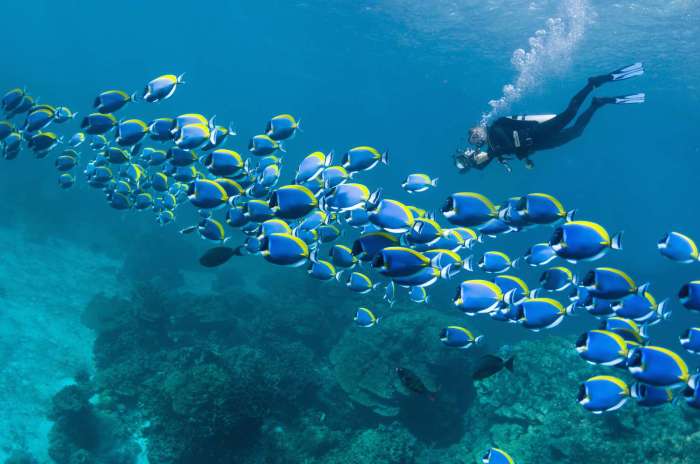
Scuba diving, while an exhilarating experience, has the potential to impact marine ecosystems. Responsible practices and conservation initiatives are crucial to minimize these impacts and preserve the delicate underwater world.
Scuba diving offers a unique opportunity to explore the wonders of the underwater world. From vibrant coral reefs teeming with life to ancient shipwrecks holding secrets of the past, there are countless scuba diving locations around the world that cater to every level of experience.
Whether you’re a seasoned diver or just starting out, there’s a scuba diving location that’s perfect for you. With its crystal-clear waters and diverse marine life, scuba diving is an unforgettable experience that will leave you with lasting memories.
The main environmental impacts of scuba diving include:
- Physical Damage: Divers can unintentionally damage coral reefs, seagrass beds, and other fragile marine habitats by touching or kicking them.
- Pollution: Discarded dive gear, sunscreen, and other pollutants can contaminate the water, harming marine life.
- Overfishing: Divers may inadvertently disturb fish populations by spearfishing or removing specimens for souvenirs.
- Noise Pollution: The sound from dive boats and equipment can disrupt marine animals’ communication and behavior.
To mitigate these impacts, responsible diving practices include:
- Buoyancy Control: Maintaining proper buoyancy prevents divers from touching or damaging marine life and habitats.
- Dive Gear Management: Divers should secure their gear to avoid accidental damage or loss.
- Waste Disposal: All trash and dive gear should be properly disposed of to prevent pollution.
- Respect for Marine Life: Divers should avoid touching, harassing, or removing marine animals.
Additionally, numerous organizations are dedicated to marine conservation and sustainable diving. These organizations implement initiatives such as:
- Reef Restoration: Growing and transplanting corals to restore damaged reefs.
- Marine Protected Areas: Establishing areas where fishing and other activities are restricted to protect marine life.
- Education and Outreach: Raising awareness about the importance of marine conservation and responsible diving practices.
The following table summarizes the environmental impacts of scuba diving, their causes, prevention measures, and conservation organizations involved in mitigating these impacts:
| Impact | Cause | Prevention | Conservation Organizations |
|---|---|---|---|
| Physical Damage | Touching or kicking marine life and habitats | Buoyancy control | Reef restoration organizations |
| Pollution | Discarded dive gear, sunscreen, and other pollutants | Dive gear management, waste disposal | Marine conservation organizations |
| Overfishing | Spearfishing, removing marine animals for souvenirs | Respect for marine life | Marine protected area organizations |
| Noise Pollution | Sound from dive boats and equipment | Use of quiet equipment, limiting dive boat noise | Noise pollution reduction organizations |
Final Wrap-Up
Our journey through scuba diving locations has unveiled the beauty and diversity of the underwater world. Whether you’re a seasoned diver or an aspiring explorer, these destinations offer an unforgettable experience that will ignite your passion for the ocean. Embrace the allure of the deep and let the wonders of the underwater realm captivate your soul.
Detailed FAQs
What are the best scuba diving destinations for beginners?
Cozumel, Mexico; Grand Cayman, Cayman Islands; and Koh Tao, Thailand, offer calm waters, excellent visibility, and gentle slopes ideal for novice divers.
How can I choose the right scuba diving destination?
Consider your experience level, interests (wreck diving, marine life encounters, etc.), budget, and the time of year you plan to travel.
What are some tips for staying safe while scuba diving?
Get certified, dive with a buddy, check your equipment thoroughly, and respect the underwater environment.